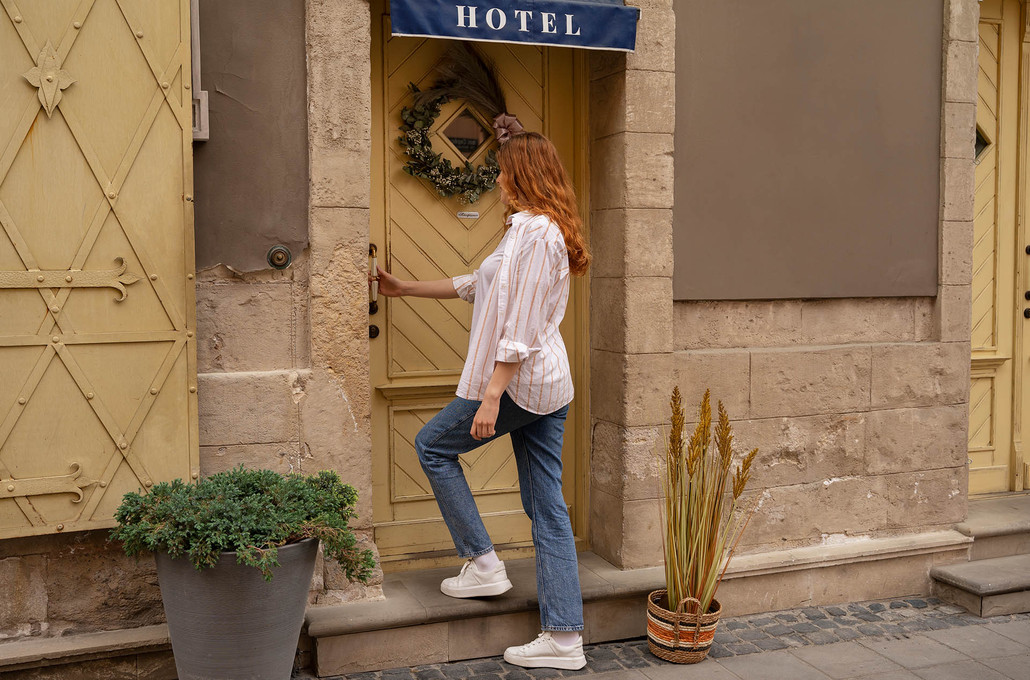
The Top 5 Hospitality Trends for 2025
Posted by Amenie on Jan 15, 2025
The hospitality industry is undergoing significant changes as we enter 2025, driven by advancements in technology, sustainability initiatives, and evolving guest expectations. Staying ahead of these trends is essential for businesses looking to attract modern travelers and bolster their long-term success. Below, we explore the top trends shaping the hospitality landscape in 2025.
1. Hyper-Personalized Guest Experiences
In 2025, personalization will be the gold standard for guest satisfaction. Travelers no longer want generic service; they crave unique, tailored experiences. Advances in AI and machine learning allow hotels to anticipate guest needs like never before, offering room customization, curated local recommendations, and personalized dining options.
For example, AI tools can suggest nearby activities based on a guest’s past preferences, while dynamic room settings—like temperature, lighting, and music—can be adjusted to align with individual tastes.
However, the challenge lies in blending technology with the human touch. Automation can streamline operations, but personalized interactions remain key to creating memorable stays. Properties that strike this balance will stand out in a competitive market.
2. Sustainability as a Core Value
Sustainability is no longer optional—it’s a necessity. Modern travelers prioritize eco-conscious accommodations that actively reduce their environmental footprint. From using renewable energy to replacing single-use plastics, sustainable initiatives appeal to environmentally aware guests and enhance operational efficiency.
- Renewable Energy Adoption: Properties are investing in solar panels, wind energy, or geothermal heating to reduce reliance on traditional energy sources. A hotel in Arizona, for instance, might install solar panels to take advantage of abundant sunlight while promoting its renewable energy commitment.
- Plastic Reduction Programs: Many properties are replacing single-use plastics with biodegradable or reusable alternatives. The states of California, New York, and Washington have already passed laws banning the use of small, single-use toiletry bottles in hotels and the expectation is that more will follow their lead.
- Water Conservation Efforts: Installing low-flow faucets, showerheads, and toilets, or even using greywater recycling systems, can significantly reduce water usage. A property in Nevada might emphasize water-saving features as part of its desert conservation efforts.

Connecting with Local Communities
- Locally Sourced Ingredients: Properties can prioritize local food producers to reduce transportation emissions and support regional agriculture. A boutique hotel in Vermont might showcase local coffees and seasonal dishes made with ingredients from nearby farms, promoting both sustainability and authenticity.
- Partnerships with Local Artisans: By collaborating with local craftspeople, properties can provide unique amenities while supporting the community. For example, a hotel in New York could offer locally made soaps, diffusers, or pottery as part of its guest experience.
- Community Impact Projects: Hotels can engage guests in community-driven initiatives, such as tree-planting events or neighborhood cleanups. A property in Seattle might host a tree-planting event, inviting guests to contribute to local sustainability efforts.
Sustainability isn’t just about reducing waste—it’s about creating an ecosystem where properties, guests, and communities thrive together. By sourcing locally and supporting regional businesses, properties not only build trust and loyalty among guests but also strengthen their connections to the places they call home. This alignment with environmental and community values resonates deeply with modern travelers who want their stays to have a positive impact.
3. Biophilic Design: Bringing Nature Indoors
Biophilic design, which incorporates natural elements into places we live, work, and play, is redefining hospitality spaces in 2025. Guests increasingly value a connection to nature, and properties are responding by creating environments that enhance well-being, reduce stress, and improve the overall guest experience.
Key Elements of Biophilic Design
- Natural Materials: Wood, stone, and other organic textures create a sense of harmony and authenticity.
- Greenery and Indoor Gardens: Living walls, potted plants, and gardens bring the outdoors inside, easily boosting air quality and visual appeal.
- Natural Lighting: Maximizing daylight through large windows, skylights, and open spaces enhances mood and reduces energy usage.
Studies have shown that biophilic spaces improve mental health, increase productivity, and promote relaxation. For example, a hotel with a lush indoor courtyard surrounded by greenery creates an oasis for guests seeking respite from urban life. Properties embracing biophilic design stand out as destinations where nature and hospitality converge.

4. Wellness-Focused Offerings
As health and well-being remain a priority for travelers, properties are reimagining their spaces and services to cater to this demand. Wellness tourism is on the rise, with guests seeking accommodations that promote relaxation, rejuvenation, and mindfulness. From spa-like amenities to wellness programs and fitness-centric features, the industry is pivoting toward a more holistic approach to guest satisfaction. Explore if it will be worth it to do fitness classes, or simply investing in workout equipment and accessories in your property.
Fitness-Centric Features and Programs
- In-Room Fitness Amenities: Properties are increasingly equipping rooms with yoga mats, resistance bands, and on-demand workout programming. Some hotels even feature indoor bikes or compact gym setups within guest rooms and suites.
- On-Site Fitness Centers: Many properties are upgrading their gyms with modern equipment, offering everything from free weights and cardio machines to specialized gear like TRX systems or Pilates reformers.
- Group Fitness Classes: Hosting fitness sessions such as yoga, Zumba, or HIIT in scenic outdoor spaces or dedicated wellness areas can attract fitness-conscious travelers. For example, Kimpton Hotels often offer complimentary yoga classes for guests.
- Personalized Fitness Services: Partnering with certified trainers or wellness coaches to offer one-on-one sessions, from guided meditation to strength training, provides a premium fitness experience.
Examples of Wellness Programs
- Spa and Relaxation Experiences: Spas offering treatments like aromatherapy massages, facials, or hydrotherapy pools remain a cornerstone of wellness tourism. Some properties, like Banyan Tree Hotels, incorporate traditional healing practices into their treatments.
- Mindfulness and Meditation Retreats: Organizing workshops or retreats focused on mindfulness, meditation, stress management, or practices like sound baths appeals to travelers seeking mental clarity and relaxation.
- Healthy Dining Options: Incorporating plant-based dishes, organic ingredients, and nutrient-rich meals into menus aligns with guests’ health priorities. Some hotels go further by offering cooking classes focused on wellness.
- Nature-Based Activities: Properties with access to natural landscapes can capitalize on this by offering guided hikes, forest bathing sessions, or outdoor yoga, blending fitness with the restorative power of nature.
Is It Worth It for Your Property?
The decision to invest in fitness classes or upgrade workout equipment depends on your property type, target demographic, and available space.
- For Smaller Properties: Simple in-room fitness kits and partnerships with local wellness providers can deliver significant guest satisfaction without major investments.
- For Larger Resorts or Urban Hotels: Full-scale fitness centers, group classes, and wellness retreats may justify the cost by attracting a health-conscious clientele and commanding higher rates.
 Commercial gym design and fitness equipment by Ardent Fitness for Sea View Luxury Rentals, Florida
Commercial gym design and fitness equipment by Ardent Fitness for Sea View Luxury Rentals, Florida
This trend goes beyond luxury resorts—it’s about creating environments that support physical and mental well-being in everyday stays. Whether it’s offering healthy menu options, providing wellness-centric room features, or partnering with local wellness experts, these initiatives resonate with modern travelers looking for restorative experiences.
5. Experiential and Community-Centric Travel
Today’s travelers increasingly prioritize experiences over possessions, seeking unique adventures that connect them with local cultures and communities. This shift has prompted the hospitality industry to embrace curated, meaningful, and authentic guest experiences. Properties that deliver these distinctive offerings not only enhance the guest journey but also foster deeper connections and lasting memories.
Examples of Experiential Offerings
- Guided Tours by Local Experts: Partnering with local guides to offer guests immersive tours of the area. For instance, a boutique hotel in Napa Valley could organize vineyard tours and wine tastings led by local vintners, providing guests with insider knowledge of California’s wine culture.
- Cultural Workshops: Hosting interactive sessions, such as pottery classes, cooking lessons, or artisan craft-making. A resort in Asheville, North Carolina, might offer guests lessons in Appalachian quilting or basket weaving, connecting them with the region’s rich craft heritage.
- Regional Cuisine Features: Highlighting local flavors through farm-to-table dining experiences, chef-led tastings, or food festivals. For example, a property in New Orleans could host Creole cuisine nights with live jazz, immersing guests in the city’s vibrant culinary and musical traditions.

Community Integration
- Sustainability Initiatives: Properties that engage in environmental efforts, such as beach cleanups, reforestation projects, or renewable energy programs, invite guests to participate in meaningful ways. A beachfront resort in Florida might organize sea turtle nesting site protection efforts, allowing guests to learn about and support conservation.
- Local Partnerships: Collaborating with local artisans, farmers, or vendors to offer unique, community-driven products and services. A hotel in Portland, Oregon, might sell locally made candles or feature an art installation by a regional artist, emphasizing the city’s creative culture.
- Community Events: Hosting or sponsoring events that celebrate local culture and heritage. A hotel in Santa Fe, New Mexico, could organize a Southwest Art Walk, featuring works from local artists and live demonstrations of traditional techniques.
This trend adds depth and authenticity to a guest’s stay, making them feel part of the local narrative rather than just spectators. Properties that actively engage with their communities create a ripple effect—benefiting the local economy, enhancing guest satisfaction, and strengthening their brand identity as a destination of choice for meaningful travel experiences.
By aligning with local values and offering unique opportunities, properties can transform the guest journey into something truly memorable and impactful.
Become a Trade Partner
Get instant access to our curated selection of hospitality products at exclusive prices—designed specially for trade professionals. Join today for special perks like discounted pricing, access to hospitality’s most-loved products, personalized support from our experienced trade team, and more.


